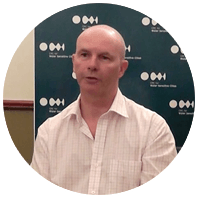Who really builds great communities? Just ask Vernon Langdon
 Good design is fundamental to great communities, but rarely do we stop and think about the huge challenges associated with successfully creating affordable homes in safe, stable, beautiful landscapes. Vernon Langdon, from Western Australia’s Department of Housing, knows better than most how fast the key concepts behind housing development are changing. These days, his vision for suburbs of the future includes parkland, waterways, and smart water sensitive urban design.
Good design is fundamental to great communities, but rarely do we stop and think about the huge challenges associated with successfully creating affordable homes in safe, stable, beautiful landscapes. Vernon Langdon, from Western Australia’s Department of Housing, knows better than most how fast the key concepts behind housing development are changing. These days, his vision for suburbs of the future includes parkland, waterways, and smart water sensitive urban design.
“We’re building communities these days, rather than just putting people in houses,” says Vernon. “We see the results for what we do, actually transforming and improving people’s lives.” Developers used to focus their efforts on delivering hard infrastructure. But things are changing fast, and now many different perspectives are brought together to help people into affordable housing.
The Ellenbrook project in Perth’s North Eastern suburbs was one of the earliest where the establishment of a functional community was prioritised, beyond just putting in roads, cutting up the blocks, and putting up the houses. Since then, this approach has evolved further to include more environmentally sensitive design, as a smart response to Perth’s challenging climate. This was the first joint venture partnership undertaken by the Department of Housing in Western Australia, and its achievements inspired many more successful alliances across the State.
“It’s very easy to ‘blue sky’ things, but then there is the reality that these ideas have to be delivered in an affordable and responsible manner,” says Vernon. “I think the CRCWSC and its research can help shape those parameters. We can work together to look at how we might be able to deliver environmentally sensitive communities, and do it in a way that might end up being cheaper than building them in traditional ways.”
In developing affordable housing, issues of cost are critical. Vernon acknowledges that the Department of Housing’s current partnership with the CRCWSC marks the first time it has engaged so heavily with a research body in the field of land development for housing. He is currently working with CRCWSC researchers to implement innovative and practical ideas to secure sustainability, resilience, and liveability for new housing estates in Western Australia.
“Approaching many of these sites as blank canvases and bringing in fresh sets of eyes has obviously fired up some great minds,” Vernon says.
The issue of high groundwater is common in areas the Department is assessing for development. He points out that the traditional way of dealing with flood risk in new projects is to bring in sand fill. But that may not always be the best option: “One of the first aims of our partnership with the CRCWSC on such projects is to find alternative ways to use that water, to see the constraint as an opportunity. The lessons we learn through demonstration projects can then be translated to other sites with similar challenges.”
Through the CRCWSC, Vernon says he has made connections with people in other Australian states who grapple with related problems. This collaboration has allowed the Department to access research and people actively working on site – to create fitting solutions for a range of land-management problems. “Before I started engaging in the CRC I felt almost intimidated by the level of intellect that I was dealing with,” he reveals. “But one of the first things I realised is that we all have a common goal, and that is to try and make things better; to create better lives for people.”
So when future residents of Perth’s new suburbs find themselves strolling along a series of beautiful and environmentally sensitive lakes, with flood risk the furthest thing from their minds, it may well be the CRCWSC and the Department of Housing that they should thank.
Averil Bones for the Mind Your Way team